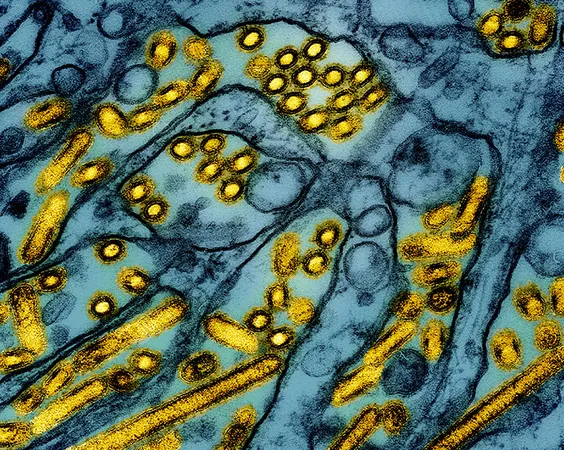
The Alarming Reality of Bird Flu: Is the World Prepared for a Pandemic?
2025-01-14
Author: Daniel
Introduction
Bird flu is surging across the United States, presenting unanticipated challenges and raising serious questions about public health implications.
Recent Fatality
Recently, a Louisiana resident tragically became the first confirmed human fatality from the H5N1 influenza virus in the U.S. This individual, aged over 65 and with pre-existing health conditions, contracted the virus through contact with both wild birds and backyard chickens. State health officials have issued warnings, yet experts state there is no immediate cause for alarm, insisting that the general risk to the public remains low.
Current Spread and Concerns
However, the relentless spread of H5N1, infecting not only avian species but also mammals—including cattle and even humans—poses new concerns. Experts stress the urgent need for surveillance and preventive strategies to mitigate risks. If H5N1 mutates to facilitate human-to-human transmission, it could lead to a broader epidemic or pandemic scenario.
Expert Opinions
Meghan Davis, a molecular epidemiologist and environmental microbiologist at Johns Hopkins, cautions, 'While there is currently no evidence of human-to-human transmission, there are concerning indicators. The future remains uncertain.' This sentiment is echoed by many in the scientific community who observe that outbreaks of this nature tend to end rapidly; however, the persistence of this strain has deviated from historical patterns, thus raising alarms.
Historical Context and Adaptability
Historically, H5N1 has been known for its lethal impact on humans, with fatality rates reaching near 50%. The current strain has shown alarming adaptability, evidenced by a concerning development earlier this year when the virus was found to infect dairy cows—a rarity for avian influenza strains. This poses significant worries regarding the dairy supply, as H5N1 could potentially be transmitted through contaminated milk.
Symptoms and Variability
Symptoms resulting from H5N1 can vary greatly, with severe respiratory issues arising predominantly from contact with wild birds and poultry. Conversely, those who encounter the strain associated with dairy farming often experience milder symptoms, resembling the seasonal flu. However, cases of conjunctivitis—characterized by redness and inflammation of the eyes—are proving to be particularly troublesome for dairy workers.
Vigilance and Potential for Mutation
Significantly, the adaptability of H5N1 demands heightened vigilance, particularly as studies reveal that some individuals might display minimal symptoms, thus unwittingly contributing to the virus's potential to mutate and spread further.
The Global Pandemic Question
A crucial question arises: what would it take for H5N1 to escalate into a global pandemic? Experts suggest that the worst-case scenario involves co-infection with another strain of influenza, facilitating a dangerous reassortment that could enhance viral transmissibility among humans.
Tracking Efforts and Concerns
Current tracking efforts indicate that 66 humans across ten states and over 900 dairy farms in 16 states have been impacted by H5N1. However, many health professionals express concern that these figures represent just the 'tip of the iceberg,' as surveillance among farmworkers—especially undocumented immigrants who may lack healthcare access—remains inadequate.
Containment Challenges
Containment efforts face challenges, particularly in agricultural hotspots like California, which has declared a state of emergency due to outbreaks among dairy farms. The interconnected nature of these farms, alongside migratory bird pathways, complicates containment measures. Effective strategies must include minimizing contact between livestock and wild birds, who are drawn to the feed and manure around dairy operations.
Public Safety Measures
To stay safe, the public is advised to avoid raw or undercooked milk and meat products and to refrain from handling dead birds or mammals. Pet owners should also be cautious, particularly with cats, who are prone to severe illness from H5N1. Keeping pets indoors and away from potential sources of infection, such as migratory waterfowl, is highly recommended.
Conclusion and Call for Vigilance
As experts and health officials monitor the situation, the possibility of H5N1 spreading beyond its current geographic confines remains a serious concern. We must all remain vigilant and proactive while awaiting further developments in this evolving story. The stakes are high; understanding the risks and taking appropriate precautions could mean the difference between containment and a potential health crisis.




 Brasil (PT)
Brasil (PT)
 Canada (EN)
Canada (EN)
 Chile (ES)
Chile (ES)
 Česko (CS)
Česko (CS)
 대한민국 (KO)
대한민국 (KO)
 España (ES)
España (ES)
 France (FR)
France (FR)
 Hong Kong (EN)
Hong Kong (EN)
 Italia (IT)
Italia (IT)
 日本 (JA)
日本 (JA)
 Magyarország (HU)
Magyarország (HU)
 Norge (NO)
Norge (NO)
 Polska (PL)
Polska (PL)
 Schweiz (DE)
Schweiz (DE)
 Singapore (EN)
Singapore (EN)
 Sverige (SV)
Sverige (SV)
 Suomi (FI)
Suomi (FI)
 Türkiye (TR)
Türkiye (TR)
 الإمارات العربية المتحدة (AR)
الإمارات العربية المتحدة (AR)